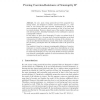Free Online Productivity Tools
i2Speak
i2Symbol
i2OCR
iTex2Img
iWeb2Print
iWeb2Shot
i2Type
iPdf2Split
iPdf2Merge
i2Bopomofo
i2Arabic
i2Style
i2Image
i2PDF
iLatex2Rtf
Sci2ools
ICICS
2010
Springer
2010
Springer
Proving Coercion-Resistance of Scantegrity II
By now, many voting protocols have been proposed that, among others, are designed to achieve coercion-resistance, i.e., resistance to vote buying and voter coercion. Scantegrity II is among the most prominent and successful such protocols in that it has been used in several elections. However, almost none of the modern voting protocols used in practice, including Scantegrity II, has undergone a rigorous cryptographic analysis. In this paper, we prove that Scantegrity II enjoys an optimal level of coercion-resistance, i.e., the same level of coercion-resistance as an ideal voting protocol (which merely reveals the outcome of the election), except for so-called forced abstention attacks. This result is obtained under the (necessary) assumption that the workstation used in the protocol is honest. Our analysis is based on a rigorous cryptographic definition of coercionresistance we recently proposed. We argue that this definition is in fact the only existing cryptographic definition of coe...
| Added | 12 Feb 2011 |
| Updated | 12 Feb 2011 |
| Type | Journal |
| Year | 2010 |
| Where | ICICS |
| Authors | Ralf Küsters, Tomasz Truderung, Andreas Vogt |
Comments (0)

